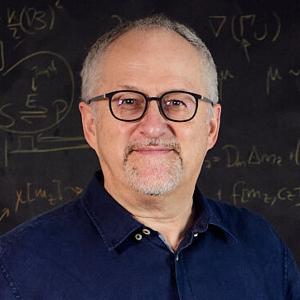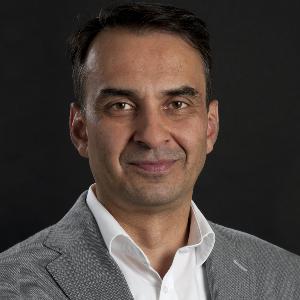ERC grants for three LMU researchers
30 Mar 2023
Hospital art, artificial life, and the legacy of international organizations: the European Research Council awards three prestigious Advanced Grants to researchers at LMU.
30 Mar 2023
Hospital art, artificial life, and the legacy of international organizations: the European Research Council awards three prestigious Advanced Grants to researchers at LMU.
Three professors at LMU were successful in the latest round of ERC grants: art historian Chiara Franceschini, biophysicist Erwin Frey, and European historian Kiran K. Patel have each received an Advanced Grant for their research projects.
The award comes with a maximum funding of €2.5 million (in exceptional cases: €3.5 million). ERC Advanced Grants are designed for established academics from all disciplines whose highly innovative research goes well beyond the current state of research and forges ahead into new research territories.

© Sonia Marrese
Chiara Franceschini is Professor of Early Modern Art History at LMU.
Art and disease are two very distant notions today, but this was not the case in the past. Especially after the Black Death of 1348, all forms of social and medical disease were hosted and confined in complex structures, which, together with their attached chapels, churches and houses, were planned as to face new epidemics and social problems and richly endowed with artworks and objects, sometimes invested with healing powers. Major architects and artists were involved in such projects, from Filarete to Alonso de Covarrubias or Pierre Puget; from Memling to Grünewald to El Greco and Rubens. Such former hospitals are still today among the most impressive buildings in European cityscapes while artworks produced for or donated to them are owned by prominent museum in Europe and the US.
Despite extensive scholarship on the history of hospitals as social institutions, one aspect has remained surprisingly underexplored: Why were art and architecture so vital for pre-modern hospital cultures? And what can we still learn today from this centrality of art for hospitals? In her new ERC project ARCHIATER (Heritage of Disease: The Art and Architectures of Early Modern Hospitals in European Cities), Chiara Franceschini interrogates this vast and understudied “heritage of disease”.
To disclose the unsuspected meanings, functions and values of hospital architecture, art and materiality across Renaissance Europe, the art historian will focus on hospital in European cities and ports before 1750 at the intersection between art history, social history of medicine and curatorial and provenance studies. She will work on interconnections and cultural exchange across the Mediterranean, diversity and disability, visibility and invisibility, and the ‘liminal’ roles of art and architecture for hospitals. The central hypothesis is that, in such contexts, structures, images and objects were crucial because they allowed for variable degrees of osmosis between the inside and the outside of the hospital through the passage of people, things and imaginations.
Chiara Franceschini studied art history and early modern history in Pisa and in Florence, Italy, and obtained her doctorate from the Scuola Normale Superiore. She was a postdoctoral researcher at the Warburg Institute in London as well as the recipient of research fellowships from international institutions including the EHESS in Paris and Columbia University in New York. She taught Medieval and Renaissance Studies at University College London, before joining the LMU in 2016. In the same year, she was awarded an ERC Starting Grant for her project SACRIMA.

© LMU
Professor Erwin Frey is Chair of Statistical and Biological Physics at LMU’s Faculty of Physics. His research focuses on understanding the universal mechanisms of living systems, which determine both their structure and their function. How can systems with life-like characteristics be built from a minimal set of components? While progress has been made at the experimental level in developing artificial cells or systems with life-like properties, there is a lack of a theoretical underpinning that can offer mechanistic principles. With his ERC project CellGeom (The geometrical and physical basis of cell-like functionality), Frey aims to identify such principles. The basic question he wants to answer is: “How can we understand, at a mechanistic level, the emergence of life-like functions in minimal systems composed of elastic membranes and protein reaction networks that form protein patterns by processing information about the membrane geometry and reshaping the membrane through mechano-chemical feedback”.
Within the project, Frey wants to develop new theoretical concepts and innovative multi-scale approaches to understand the physical principles that underlie elementary biological functions. “This research will give us unprecedented insights into how living systems work. We will understand how the interplay between the elastic properties of cell membranes and the spatiotemporal self-organization of proteins leads to cell-like behaviors such as cell migration and cell division,” says Frey.
“My approach is to harness the power of nature's very own methods and leverage evolutionary algorithms to unveil design principles that can drive breakthrough advancements in the development of artificial cells”. ” Even more, the new approaches will allow him to analyze the potential of these minimal systems for the emergence of collective functions such as cell-cell communication. enable the. Frey expects this to yield new theoretical insights into the physical principles of biological functions, enabling him to furnish innovative suggestions for the rational design of systems with life-like functionalities.
Erwin Frey received his habilitation degree in theoretical physics at TU Munich in 1996, where he had also completed his doctoral studies. As a Heisenberg fellow, he conducted research at Harvard University, was a visiting professor at LMU, and held a full professorship at the Free University of Berlin. Subsequently, he also led the Theory Department at the Hahn-Meitner-Institute in Berlin before taking up an appointment as a Chair of Statistical and Biological Physics at LMU in 2004.

© LMU
Kiran Klaus Patel is Professor of European History (19th and 20th Century) and Director of Project House Europe, the center for interdisciplinary research on the history of contemporary Europe at LMU.
In times of globalization and international conflicts, countries have to cooperate and band together. This explains why over the past few decades we have seen so many councils, alliances, and organizations emerge on to the global stage of business and politics.
International organizations (IOs) are generally thought to be a success story. But what happens when one of them ceases to exist? Are underlying ideological principles and practices preserved? And what happens to the people who were involved and the buildings where they worked?
Astonishingly little is known about these legacies, even though more than a third of IOs founded since 1815 have gone out of existence. It seldom transpires, however, that the IOs simply disappear without trace. Most of them still have a posthumous influence on their successors, even if current interpretations and narratives are happy to ignore or downplay such connections.
Kiran Klaus Patel wants to comprehensively study this neglected side of international history. In the course of his project “InechO – Hidden Legacies: How discontinued International Organizations have shaped European governance since the 1910s,” for which he has received an ERC Advanced Grant, he will work with an international team to research the afterlife of European and international organizations since the 1910s and the hidden connections between IOs that have been studied separately before now.
The insights from this research could be applied to current developments: “Today’s world is witness to dramatic changes in the international order,” says Patel. The period investigated in the project is not a mummified past, but it affords important insights into the present. “Although no international organization has been discontinued to date, that could change, making the researched questions all the more topical.”
Before Patel came to LMU, he held chairs at Maastricht University and at the European University Institute in Florence as well as a junior professorship at Humboldt University in Berlin. He has been a visiting fellow at academic institutions such as the School for Advanced Studies in the Social Sciences in Paris, the Free University of Berlin, the University of Freiburg, Harvard University, the London School of Economics, Sciences Po in Paris, and the University of Oxford.